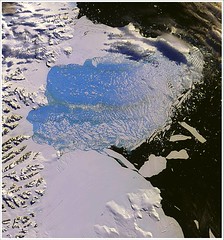 歐洲環境衛星Envisat在軌道上已經10年了,歐洲太空總署表示,這個衛星正持續觀察氣候變遷造成的南極冰棚快速退後的現象。
歐洲環境衛星Envisat在軌道上已經10年了,歐洲太空總署表示,這個衛星正持續觀察氣候變遷造成的南極冰棚快速退後的現象。
這個衛星於2002年3月1日發射後的首次觀測行動之一,便是崩裂一大塊主要部份的南極拉森B冰棚 (Larsen B ice shelf)。
歐洲太空總署表示,那次的崩裂「由於氣候暖化引發的冰層結構不穩定」,廣達 3200 平方公里的冰層在幾天內崩解。
經過 10 年來,利用先進合成孔徑雷達(ASAR)的觀測,歐洲環境衛星發現拉森B冰棚在這10年間又減少了 1790 平方公里的面積。
 奧地利因斯布魯克大學氣象與地球物理系教授Helmut Rott說,「冰棚對大氣暖化以及洋流與溫度的改變很敏感。」
奧地利因斯布魯克大學氣象與地球物理系教授Helmut Rott說,「冰棚對大氣暖化以及洋流與溫度的改變很敏感。」
「南極半島北部在過去 50 年間,大氣溫度上升了大約攝氏 2.5 度」Rott教授說道,「暖化的趨勢比全球平均狀況更嚴重,造成了冰棚的退後與崩解。」
拉森B冰棚在1995年1月至2002年2月間,發生了幾次崩塌事件,使面積由11512平方公里縮減為 6664平方公里。
2002年3月的崩解使得所剩下的面積僅剩3463平方公里。而歐洲環境衛星今日測得的面積則只有1670平方公里。
Rott指出,「氣候模式預測了高緯度地區劇烈的暖化現象,歐洲環境衛星對拉森冰棚的觀測證實了冰棚對氣候暖化的脆弱性,並顯示了冰棚對冰川上游穩定的重要性。」
 類似歐洲環境衛星的 ASAR,地球觀測衛星的雷達對監測極地區特別有用,因為雷達可以穿透雲層並在黑暗中取得影像。
類似歐洲環境衛星的 ASAR,地球觀測衛星的雷達對監測極地區特別有用,因為雷達可以穿透雲層並在黑暗中取得影像。
歐洲環境衛星的壽命已經超過設計使用年限的兩倍,但仍將繼續監測地球的冰帽、陸地、海洋以及大氣至少兩年。以確保新一代人造衛星計畫「前哨兵」(Sentinels)於2013年運作之前,還能繼續取得重要的地球觀測資料。
前哨兵計畫一開始,是歐洲全球環境與安全監測計畫 (GMES) 的一部分,將會由雷達觀測開始執行。
As the Envisat satellite marks 10 years in orbit, the European Space Agency says the instruments onboard continue to observe the rapid retreat of one of Antarctica's ice shelves due to climate change.
One of the satellite's first observations after its launch on March 1, 2002 was the break-up of a main section of the Larsen B ice shelf in Antarctica.
During that break-up, 3,200 square kilometers (1,235 square miles) of ice disintegrated within a few days "due to mechanical instabilities of the ice masses triggered by climate warming," according to the European Space Agency.
Now, with 10 years of observations using its Advanced Synthetic Aperture Radar, ASAR, Envisat has mapped an additional loss in Larsen B's area of 1,790 sq km (690 square miles) over the past decade.
"Ice shelves are sensitive to atmospheric warming and to changes in ocean currents and temperatures," said Professor Helmut Rott from the Institute of Meteorology and Geophysics at the University of Innsbruck in Austria.
"The northern Antarctic Peninsula has been subject to atmospheric warming of about 2.5°C over the last 50 years," said Professor Rott, "a much stronger warming trend than on global average, causing retreat and disintegration of ice shelves."
Larsen B decreased in area from 11,512 sq km in early January 1995 to 6,664 sq km in February 2002 due to several calving events.
The disintegration in March 2002 left behind only 3,463 sq km. Today, Envisat shows that only 1,670 sq km remain.
"Climate models are predicting drastic warming for high latitudes," he said. "The Envisat observations of the Larsen Ice Shelf confirm the vulnerability of ice shelves to climatic warming and demonstrate the importance of ice shelves for the stability of glaciers upstream."
Radars on Earth observation satellites, such as Envisat's ASAR, are particularly useful for monitoring polar regions because they can acquire images through clouds and darkness.
Envisat has already doubled its planned lifetime, but is scheduled to continue observations of Earth's ice caps, land, oceans and atmosphere for at least another two years.
This ensures the continuity of crucial Earth observation data until the next generation of satellites, the Sentinels, begin operations in 2013.
The Sentinel missions, being developed as part of Europe's Global Monitoring for Environment and Security program, will continue with radar observations.







